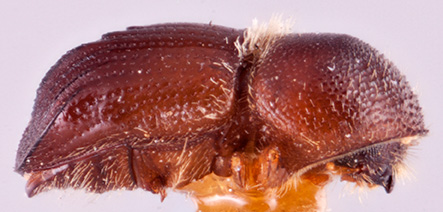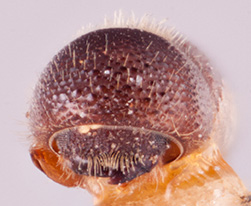Coptodryas concinna
|
Coptodryas concinna lateral; R.K. Osborn |
|
Coptodryas concinna dorsal; R.K. Osborn |
|
Coptodryas concinna declivity; R.K. Osborn |
|
Coptodryas concinna frontal; R.K. Osborn |
Taxonomic history
Xyleborus concinnus Beeson, 1930: 214.
Coptodryas concinnus (Beeson): Wood, 1989: 171.
Synonyms
Xyleborus flexicostatus Schedl, 1942c: 31. Kalshoven 1959b: 152. Wood 1989: 171.
Diagnosis
2.3 mm long (mean = 2.3 mm; n = 4); 2.09−2.3 times as long as wide. This species can be distinguished by the dense tuft of setaeseta:
small hair-like or scale-like structure
along the elytralelytral:
pertaining to the elytra
basebase:
point or edge closest to the body; opposite of apex extending to interstriaeinterstria:
extending to interstriaeinterstria:
longitudinal spaces along the elytra between the striae, which is not as<br />
impressed and bear smaller punctures.
 4; body glabrousglabrous:
4; body glabrousglabrous:
smooth, devoid of vestiture
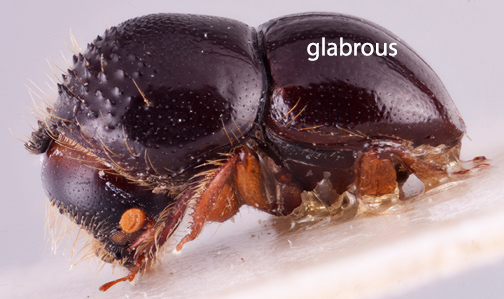 except for pronotalpronotal:
except for pronotalpronotal:
pertaining to the pronotum
and elytralelytral:
pertaining to the elytra
bases; striaestria:
punctures in rows, which may or may not be impressed to make grooves and interstriaeinterstria:
and interstriaeinterstria:
longitudinal spaces along the elytra between the striae, which is not as<br />
impressed and bear smaller punctures.
 uniseriate punctatepunctate:
uniseriate punctatepunctate:
set with fine impressed points, appearing as pin pricks
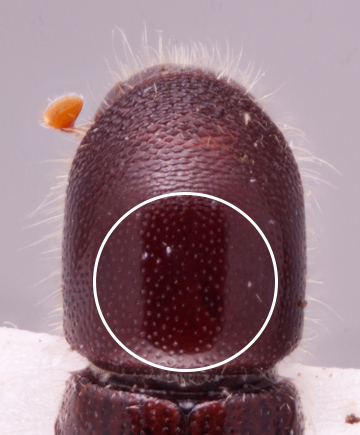 , elytralelytral:
, elytralelytral:
pertaining to the elytra
discdisc:
the flat central upper surface of any body part (e.g. pronotum and elytra) strongly shiningshining:
strongly shiningshining:
appearing glossy or bright in luster; referring to a surface that is polished and reflects light well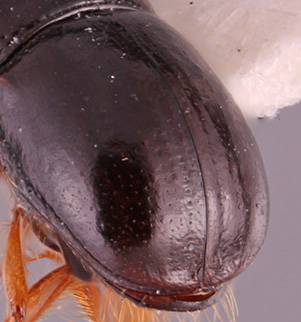 ; declivitydeclivity:
; declivitydeclivity:
downward slope of either the pronotum or elytra
 shagreened; declivitydeclivity:
shagreened; declivitydeclivity:
downward slope of either the pronotum or elytra
 bisulcatebisulcate:
bisulcatebisulcate:
pertaining to an elytral declivity with two suci; a sulcus present on each elytron but the suture remains convex
, interstriaeinterstria:
longitudinal spaces along the elytra between the striae, which is not as<br />
impressed and bear smaller punctures.
 2 to striaestria:
2 to striaestria:
punctures in rows, which may or may not be impressed to make grooves 3 moderately depressed, interstriaeinterstria:
3 moderately depressed, interstriaeinterstria:
longitudinal spaces along the elytra between the striae, which is not as<br />
impressed and bear smaller punctures.
 4−7 carinate, interstriaeinterstria:
4−7 carinate, interstriaeinterstria:
longitudinal spaces along the elytra between the striae, which is not as<br />
impressed and bear smaller punctures.
 4 strongly tumescent and sharply carinate from basebase:
4 strongly tumescent and sharply carinate from basebase:
point or edge closest to the body; opposite of apex to apicalapex:
to apicalapex:
point or edge furthest from the body; opposite of base
 quarter; posterolateralposterolateral:
quarter; posterolateralposterolateral:
relating to end of the side part/portion
 margin carinate to interstriaeinterstria:
margin carinate to interstriaeinterstria:
longitudinal spaces along the elytra between the striae, which is not as<br />
impressed and bear smaller punctures.
 7; protibiaprotibia:
7; protibiaprotibia:
tibia of the first pair of legs
distinctly triangular; pronotumpronotum:
the dorsal surface of the thorax
rounded, robust (type 5) when viewed laterally and rounded (type 1) when viewed dorsally.
May be confused with
Coptodryas amydra, C. carinata, C. elegans, andC. nudipennis
Distribution
China (Hong Kong, Yunnan), India (West Bengal), Indonesia (Java), Myanmar, Thailand
Host plants
recorded from Albizia (Fabaceae), Camellia (Theaceae), and Lansium (Meliaceae) (Beeson 1930Beeson 1930:
Beeson CFC. 1930. The biology of the genus Xyleborus , with more new species. Indian Forest Records 14: 209-272., Kalshoven 1959bKalshoven 1959b:
Kalshoven LGE. 1959b. Studies on the biology of Indonesian Scolytoidea 4. Data on the habits of Scolytidae. Second part. Tijdschrift voor Entomologie 102: 135-173 + pls. 15-22., Maiti and Saha 2004Maiti and Saha 2004:
Maiti PK, Saha N. 2004. Fauna of India and the adjacent countries. Scolytidae: Coleoptera (bark and ambrosia beetles). Vol. 1. Part 1. Zoological Survey of India, Kolkata, 268 pp.)
Remarks
Records of Coptodryas elegans (Sampson) in Beaver et al. (2014) should be referred to this species.
DNA data
specimens not available for sequencing

